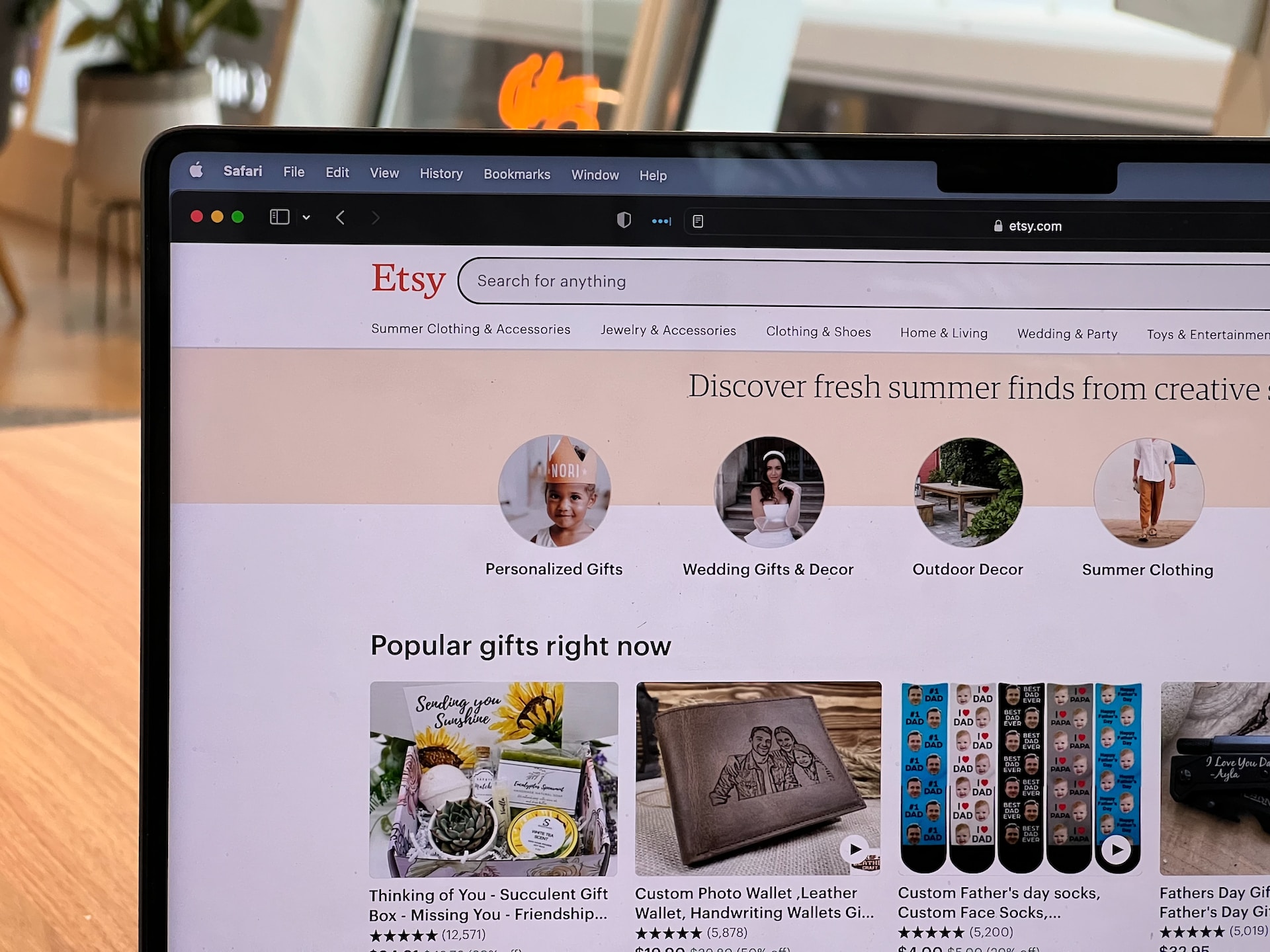With the rapid growth of online shopping, it’s the perfect time for entrepreneurs to start their own online stores. But getting your virtual storefront is often easier said than done. You’ll need to identify the right niche, come up with a list of offerings, develop a marketing strategy, and create a customer retention plan. Plus, you’ll need to identify ways to fund your new online business if you don’t have the cash to invest when starting out.
This detailed guide provides strategies for successfully executing all these steps. It also dives into the ins and outs of eCommerce business financing and strategies to help boost your approval odds.
Unique Challenges of eCommerce Businesses
It’s common to face hurdles when starting an eCommerce business. Below are some common challenges you may encounter.
Finding the Right Product and Niche
As an eCommerce business owner, you need to select the right products and niche to focus on. Researching and identifying customer demands, preferences, and competition in your chosen niche is equally important. By understanding the market, you’ll be able to offer a unique value proposition to your customers and differentiate your business from others in the industry.
Sourcing and Logistics
Your eCommerce business’s success depends on sourcing products from reliable suppliers and managing logistics effectively. Building relationships with manufacturers and wholesalers, negotiating pricing, and ensuring timely delivery can be demanding but are essential for your business’s growth. Streamlining inventory management and shipping processes will also help you maintain order fulfillment and keep customers happy.
Attracting Customers to Your Platform
Attracting customers to your eCommerce platform can be another major roadblock. You need to create an online presence by investing in SEO, social media marketing and online advertising. Engaging with your target audience through valuable content and leveraging email marketing can improve your visibility and help bring prospective customers to your platform.
Increasing Visits and Sales
Driving traffic to your eCommerce site isn’t enough; you must also convert those visitors into customers. To do so, focus on optimizing your website’s user experience, which could include clear product descriptions, easy navigation and a seamless checkout process. Offering promotions, deals and personalized shopping experiences can also help boost sales and improve customer satisfaction.
Customer Experience and Retention
Maintaining a high level of customer satisfaction and retention is essential for any eCommerce business. Providing exceptional customer service, addressing customer inquiries promptly, and implementing an effective return policy can help you create loyal customers. Additionally, collecting and analyzing customer feedback can be invaluable in making improvements and meeting your customers’ needs.
What Is eCommerce Financing?
eCommerce financing refers to the various funding options available for your online business to support its growth, manage cash flow and cover operational expenses. As an eCommerce entrepreneur, having access to working capital is crucial for the success of your business.
One way to secure eCommerce funding is through traditional loans, which are often difficult to obtain, especially for online businesses. However, Small Business Administration (SBA) loans guaranteed by the U.S. government are a viable option. Banks typically offer these loans and are geared toward supporting small businesses.
Another popular financing option for eCommerce businesses is a line of credit. Lines of credit provide you with flexible access to funds when you need them. This is particularly useful for managing the cyclical and unpredictable cash flow that is common in the eCommerce industry.
Are There Lenders Specializing in eCommerce Business Financing?
There are lenders specializing in eCommerce business financing. They understand the unique needs and challenges faced by eCommerce businesses and offer tailored solutions to help grow your online store.
Online lenders that offer eCommerce-specific funding options typically have a more streamlined application process than traditional banks. They can provide quick access to funds, which can be particularly valuable for scaling an eCommerce business in a competitive market. Plus, they usually consider aspects like your online sales volume, store performance, and credit score to determine the loan eligibility and terms.
Asset-based lending can be an excellent choice for eCommerce businesses with valuable assets, such as inventory or equipment. These loans use your business assets as collateral, allowing you to secure funding with lower interest rates.
Crowdfunding is another popular alternative for eCommerce businesses. By tapping into your customer base and community, you can raise capital to expand your product line, fund a marketing campaign, or develop new technologies. Many eCommerce businesses have successfully used crowdfunding platforms like Kickstarter and Indiegogo to raise funds for growth.
In addition to these options, Small Business Administration (SBA) loans can serve as a viable option for eCommerce businesses. SBA loans are government-backed and issued by approved banks, offering competitive interest rates and flexible repayment terms. However, the application process can be lengthy, and meeting the eligibility requirements might prove challenging.
How Can eCommerce Funding Impact Your Business
Funding allows eCommerce startups to raise enough money to get off the ground. Not everyone has enough personal funds to acquire inventory, initiate product development and make other types of investments. For some people, funding is the only path forward, and it can also help with sustainable growth. Funding can fill in the gaps during slower months and help you retain your most talented workers.
Are There Any Specific Risks Associated with eCommerce Funding?
eCommerce funding has risks, but they aren’t specific to the industry. You run the risk of giving up too much equity if you rely on angel investors and venture capital firms. A common risk for any business is paying too much interest or not keeping up with the monthly payments. It’s also possible for a good business model to go bust due to over-expansion.
What Are Your Options for eCommerce Funding?
eCommerce businesses need capital to buy inventory, tap into advertising, and fulfill other investments. These are some of your choices.
Revenue Based Financing
Alternative lenders will review your company’s revenue and request that you make a monthly payment equal to a percentage of gross revenue for the month. This approach results in fluctuating payments based on your monthly revenue. Generating more sales will result in a higher payment.
Stenn offers a strategic revenue-based funding solution designed for eCommerce businesses seeking access to working capital without the limitations of traditional loans. This financing solution provides flexibility and freedom for eCommerce companies looking to invest in inventory, expand marketing efforts, or enhance technology infrastructure without being burdened by strict repayment terms. With a proven track record of delivering over $20 billion in funding to various eCommerce and SaaS businesses, Stenn is a reliable partner in helping companies fuel their business growth. To see how much your eCommerce business would qualify for or learn more about this financing solution with n no obligation, fill out this simple form to contact Stenn.
Benefits:
- Lower monthly payments in the beginning if revenue is lower
- No fixed monthly payment that doesn’t account for your company’s financial strength at the time
- Quick approval and generous credit score requirements for some lenders
Drawbacks:
- You must fulfill a minimum annual gross revenue requirement
- You can end up paying far more than the loan’s amount if your business grows quickly
- High factor rate
Angel Investors
Angel investors are individual investors who invest their capital into small businesses and startups. These investors typically have personal assets that exceed $1 million.
Benefits:
- Receive capital without having to pay it back right away
- Get additional expertise. Some angel investors don’t only help with their capital
- No need to worry about high interest rates
Drawbacks:
- This method of equity financing involves giving up a percentage of your business
- The angel investor can realize a much higher return on the business than a lender if your company performs well
- You will have to spend a lot of time reaching out to potential angel investors and building relationships
Venture Capital
Venture capital is the higher level of angel investing. These firms have more capital than angel investors and larger teams to review business opportunities.
Benefits:
- Access to more capital
- Venture capitalists and professionals from the firm can assist with your business
- No monthly loan payments
Drawbacks:
- Lose equity
- Venture capital firms typically want more equity than angel investors
- You will have to pitch your business to several venture capital firms and build relationships to get capital
Crowdfunding
eCommerce sellers can turn to the masses for a viable funding solution. Crowdfunding allows online retailers to request funds from individuals in exchange for perks. You can get the initial capital needed to launch a product or receive support to make your company more sustainable.
Benefits:
- Receive money from many individuals
- Build up a loyal fanbase
- No interest or equity dilution
Drawbacks:
- It can take a while to raise funds
- You will have to offer perks like free products for contributors
- You must fulfill a crowdfunding platform’s requirements
Traditional Bank Loans
Financial institutions are eager to help businesses, and some of them even help startups. These loans have rates and terms, and you can get a better deal for your business funding if you have a good credit score.
Benefits:
- Quick financing
- Significant capital
- Get better rates if you have good credit
Drawbacks:
- Credit and income requirements
- Some lenders will request that you make a personal guarantee
- Not every lender gives out eCommerce loans to startups
Line of Credit
A line of credit offers flexible access to money. After the draw period, the remaining balance can be converted into a loan. You still have to make the minimum monthly payment, and you will have to pay interest over the life of the financial product.
Benefits:
- Quick funding
- Flexibility with when you repay the loan
- You only pay interest if you borrow against the line of credit
Drawbacks:
- Variable interest rate
- The potential for debt to linger and grow faster than a traditional loan
- Credit score and revenue requirements
Credit Cards
You can use personal and business credit cards to get the capital that you need. Business credit cards are better since they typically have higher credit limits and better rewards for business spending.
Benefits:
- Access capital quickly
- Repay the minimum monthly payment if you cannot pay off the entire balance right away
- You can use the cards that you already have and add new ones to your account if necessary
Drawbacks:
- High-interest rates
- The potential for debt to compound quickly
- You won’t have as much available credit remaining on your cards for other expenses
Invoice Financing
Business founders with unpaid invoices can use invoice financing for easy access to additional capital. You receive a percentage of your invoice upfront and pay interest. You can then repay the obligation after receiving the invoice payment.
Benefits:
- Continue to work with customers while a factoring company requests invoice payments for you
- Quick access to capital
- No credit score requirements
Drawbacks:
- You still have to collect the invoices and communicate with customers
- Losing a percentage of each invoice you finance
- Less capital is available with this model
Merchant Cash Advance
As an eCommerce business owner, a merchant cash advance (MCA) is one funding option you should consider. An MCA is a type of short-term financing that provides you with a lump sum of capital in exchange for a percentage of your future credit card sales. This financing option can be a good choice for businesses with unpredictable revenue or seasonal sales patterns.
You’ll need to demonstrate a consistent history of credit card sales to obtain a merchant cash advance. Lenders will evaluate your sales history to determine the advance amount and the percentage of your sales that will be dedicated to repaying the advance.
One of the key benefits of a merchant cash advance is that the approval process is typically faster than other types of financing, and funds can be deposited into your account within a few days. Additionally, there are no fixed monthly payments, which can be helpful for businesses with fluctuating revenue. However, it’s important to note that merchant cash advances often come with higher interest rates than other financing options, and the repayment terms can be shorter.
When considering a merchant cash advance, it’s important to carefully evaluate the terms and fees associated with the advance. Make sure you understand the percentage of your sales that will be dedicated to repaying the advance, as well as any additional fees or charges. It’s also important to consider whether a merchant cash advance is the best fit for your business’s financial needs and goals.
Benefits:
- Quick access to funds: Merchant cash advances are typically approved and funded faster than traditional loans, sometimes within just a few days.
- No collateral required: Unlike many other types of funding, a merchant cash advance does not require you to put up any collateral, which makes it less risky for your business.
- Flexible repayment terms: Since your repayments are based on a percentage of your sales, your payments will be lower during slower months, making it easier to manage your cash flow.
Drawbacks:
- Higher interest rates: Merchant cash advances often have higher interest rates than traditional loans, which may make it more expensive to finance your eCommerce business this way.
- No early repayment benefits: Since the total amount owed is determined upfront, paying off the advance early will not reduce the total repayment amount.
- Potential impact on cash flow: If your sales suddenly drop, the percentage repayment can significantly impact your business’s available cash, potentially affecting your ability to cover operating expenses.
Tips to Secure Funding for Your eCommerce Business
When you’re ready to apply for financing, develop a viable business plan along with financial projections to submit to the lender. It’s equally important to gather the documents they’ll need to consider you for a loan.
Building a Solid Business Plan
A well-structured business plan is critical when seeking funding for your eCommerce business. Your business plan should clearly outline your objectives, market analysis, and the strategies you’ll implement to achieve your goals. This document will show potential investors and funding sources that you have a clear vision and have put thought into how you will reach success. Consider including information about your target audience, product offering, and marketing plan. A thorough business plan will not only help you to secure funding but also serve as a useful roadmap for your business’s growth.
Coming Up with a Detailed Financial Model
A detailed financial model is also essential for demonstrating your understanding of your eCommerce business’s finances. This model should analyze your expected cash flow, including projected revenues, costs, and profitability.
It’s important to analyze various scenarios to show how your business will adapt to different situations, such as periods of high or low demand. Investors and funding sources like bank loans and angel investors will find this information particularly valuable when assessing your business’s potential.
Prepare Documents and Requirements Before Applying
Before applying for funding, it’s essential to prepare all the necessary information and documents and meet any requirements set by your chosen funding source. This may include:
- Credit score: Ensure you have a good personal and business credit score, as this will impact your eligibility for certain funding options.
- Business registration: Make sure your eCommerce business is properly registered and complies with all relevant regulations.
- Bank statements: Provide recent business bank statements to show the financial health of your business.
- Collateral: Some funding options, like asset-based lending, may require you to provide collateral, such as inventory or equipment, as security.
Taking time to prepare these documents in advance will show potential funding sources that you are organized and serious about your eCommerce business. It will also increase the likelihood of receiving the funding you need to grow.
FAQ About eCommerce Funding
Funding qualification depends on the type of loan you are applying for. Some loans have high credit score requirements, while you only need to generate a sufficient amount of annual gross revenue for others. The qualification parameters vary for different types of financing.
Terms and conditions for eCommerce funding vary for each business. You will have to make monthly payments for a traditional bank loan and pay interest based on your creditworthiness, revenue, and other factors. The terms and conditions vary for other financing options and may involve equity (i.e., angel investors and venture capital firms).







